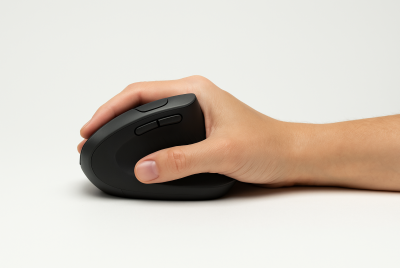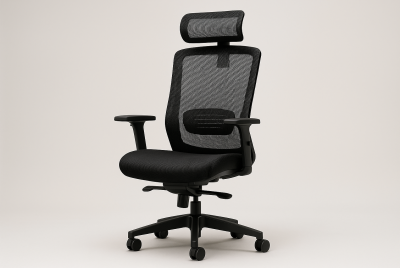Ergonomic Hazards In The Workplace And How To Prevent Them
We may earn a commission for purchases made using our links. Please see our disclosure to learn more.
Have you ever had a sore back, stiff neck, or aching wrists after you came home from work? Well, we’re here to tell you that you’re not alone. Office jobs might seem physically easy. But the thing is, they come with their own set of challenges for the body. These ergonomic hazards might not be as obvious as any type of physical work, but they’re just as important to address if you want to be comfortable and healthy. That’s why today we decided to break down the most common ergonomic hazards, how they affect you, and what you can do to prevent them.
What Are Ergonomic Hazards?
Ergonomic hazards are workplace conditions that put unnecessary strain on your body. In an office, these hazards often include repetitive movements, awkward postures, or poorly designed workspaces. Over time, these issues can lead to a lot of pain and even long-term injuries like carpal tunnel syndrome or chronic back pain. The good news? With a little bit of effort and some simple adjustments, you can create an office environment with ergonomic safety in mind.
Most Common Ergonomic Hazards In The Office
- Poor Posture
You slouch at your desk, strain your neck to look at a poorly positioned monitor, or sit for hours. This behavior can wreak havoc on your posture. Bad posture isn’t just about looking like a hunchback – it can cause back pain, neck strain, and even reduce your energy levels.
- Repetitive Movements
This is when you type, click a mouse, or even write down notes over and over. Repetitive movements can strain your muscles and tendons, potentially leading to bigger issues such as carpal tunnel syndrome.
- Improper Desk Setup
You work at a desk that’s too high, use a chair without proper support, or even use a monitor at the wrong height. This can force your body into awkward positions. These setups might not feel like a big deal at first, but over time, they can lead to serious discomfort.
- Screen Glare and Poor Light
When you strain to see your screen because of glare or dim light, it can cause eye strain and headaches. You might not notice it at first, but after hours of squinting at your monitor, it becomes hard to ignore.
- Lack of Movement
Long periods without movement are one of the biggest ergonomic hazards in the office. This is connected to a host of health issues – from back pain to reduced circulation and even an increased risk of chronic diseases.
How To Prevent Ergonomic Hazards
Now that we identified the ergonomic risk factors, let’s talk about the solutions.
Here is how to prevent ergonomic hazards and make your office setup work for you:
- Set Up Your Workspace Right
A good workspace is the foundation of office ergonomics.
Here are a few good investments as an example:
- Chair – Invest in a chair with adjustable height, lumbar support, and armrests. When you sit, your feet should be flat on the floor, and your knees should be at a 90-degree angle.
- Desk – Your desk should be at a height where your elbows can rest at a 90-degree angle while you type.
- Monitor – Position your monitor so the top of the screen is at or just below eye level. This reduces neck strain.
- Keyboard and Mouse – Keep them at a comfortable height where your wrists can stay straight and your shoulders relaxed.
- Have A Good Posture
Good posture is key if you want to prevent any ergonomic hazards. Take a look at our list below:
- When you sit, try to keep your back straight and shoulders relaxed.
- Also, try to keep your feet flat on the floor (or on a footrest if necessary).
- Avoid leaning forward or slouching. Your chair’s backrest should support your lower back.

- Take Breaks Often
When you stay in one position for too long, it isn’t great for your body. Instead, try to:
- Take a 5-10 minute break every hour. Use this time to stand up, stretch, or walk around.
- Follow the 20-20-20 rule. After 20 minutes have passed, step away from your monitor and look at something 20 feet away for 20 seconds. This will reduce eye strain.
- Move
Add movement to your workday. This way you can minimize the effects of sitting for long periods. We recommend you try this:
- Use a standing desk or an adjustable desk converter so you can sit or stand whenever you want to.
- Do some simple stretches at your desk to keep your muscles flexible.
- Take a short walk during lunch or short breaks to boost circulation.
Research on Workplace Ergonomic Risks
A Cochrane systematic review examined various ergonomic interventions for preventing musculoskeletal disorders (MSDs) among office workers, finding mixed evidence of their effectiveness. Similarly, a study on ergonomic risk management highlighted how poor ergonomics can reduce productivity and harm employee well-being, emphasizing the need for comprehensive safety measures.
Best Ergonomic Solutions for the Office
Poor ergonomics in the office can lead to strain, discomfort, and long-term injuries. Investing in the right ergonomic products can help create a healthier workspace.
- Ergonomic Office Chair – Provides lumbar support and promotes proper posture.
- Adjustable Standing Desk – Reduces prolonged sitting and encourages movement.
- Ergonomic Keyboard & Mouse – Minimizes wrist strain and supports natural hand positioning.
- Monitor Stand or Adjustable Arm – Keeps screens at eye level to prevent neck strain.
- Anti-Fatigue Mat – Offers cushioning for those using standing desks.
- Footrest – Improves leg circulation and reduces lower back pressure.
These ergonomic solutions help create a safer and more comfortable office environment while reducing the risk of workplace-related injuries.

Signs You Might Need Help
Sometimes, despite your best efforts, you might still experience discomfort. These are the signs you should be aware of:
- Persistent pain in your back, neck, shoulders, or wrists.
- Tingly or numb fingers.
- Frequent headaches or eye strain.
If these issues continue, immediately consult your healthcare provider.
When you want to prevent ergonomic hazards from happening to you, remember that this doesn’t have to be complicated or expensive. All you need are a few thoughtful adjustments to your workspace and daily habits. This is how you can protect your body from unnecessary strain and discomfort.
Remember, small changes can make a big difference long term. So, take a moment to assess ergonomic risk factors and adjust your setup accordingly. Then, make a plan, and give your body the support it deserves. Your body will thank you!
Keep on reading our blogs – we have a lot more waiting for you!




